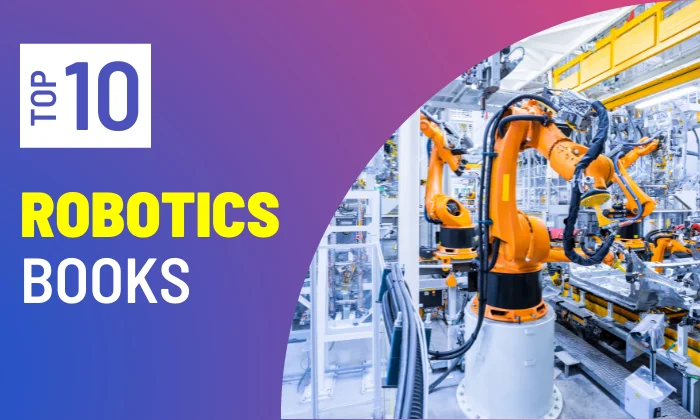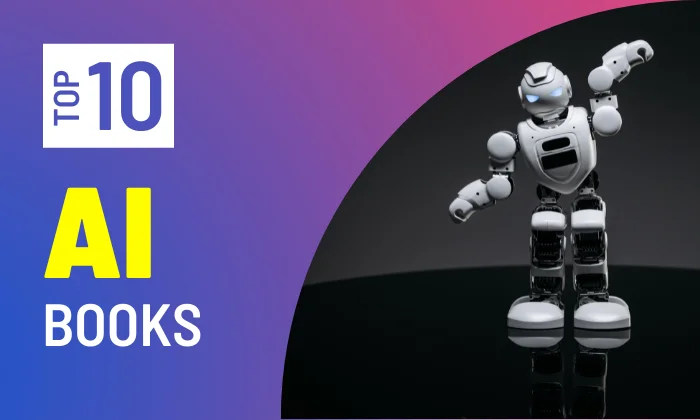Robotics is an interesting area of research nowadays and its importance in the 21st century can no longer be ignored. Here is a list of the top 10 books on Robotics.

1. Robotics: A Very Short Introduction
By Alan Winfield
This book examines the impact of one of the modern world’s most important technologies. The author highlights the importance of robotics by considering them in a range of settings, from traditional industry and warehouse automation to innovative applications in homes and hospitals. It also introduces robots as lifelike replicas by dissecting the components that make up a robot to form a mental picture of what a robot is, how it functions, and how ‘intelligent’ it is. The book also highlights the success of robotics in planetary exploration.
It also emphasizes the importance of the future of robotics research and applications. It’s a part of the best-selling series. The series of Very Short Introductions has sold millions of copies throughout the world.
2. Robotics: Everything You Need to Know About Robotics from Beginner to Expert
By Peter Mckinnon
This book provides a review and research on the World of Robotics. Everything in this book will develop the interest of the reader. From beginner to expert level, all the information related to robotics is in this book. You’ll learn about robotics’ history and the Three Rules related to robotics.
The numerous hardware components of today’s robots are also described e.g. Analog and Digital Intelligence, Stepper, Servo & DC Motors, and Light Sensors & Bump Sensors.
This book also shows you how to build an autonomous wall-climbing robot. RoboCORE software fundamentals and how to develop “brains” for projects like the Obstacle Avoiding Robot are also covered. You’ll be delighted you learned this relevant and reliable information from this great book.
3. Probabilistic Robotics (Intelligent Robotics and Autonomous Agents series) 1st Edition
By Sebastian Thrun, Wolfram Burgard, Dieter Fox
Probabilistic robotics is a new and evolving field in robotics that deals with thinking and control in the presence of uncertainty. Probabilistic robotics, which builds on quantitative statistics, gives robots a whole new level of robustness in real-world scenarios. This book introduces the reader to a range of strategies and algorithms. All algorithms are based on the same modeling tool.
Each chapter includes pseudo-code implementation examples, extensive mathematical derivation, expert opinion discussions, and a long number of assignments and class projects. Those who want to research the field of robotic science and software related to robotics can benefit from this book.
4. Introduction to Autonomous Mobile Robots (Intelligent Robotics and Autonomous Agents series) second edition
By Roland Siegwart, Illah Reza Nourbakhsh, Davide Scaramuzza
This revised and updated second edition includes 130 pages of additional content on locomotion, perception, location, and planning, and navigation.
An Introduction to Autonomous Mobile Robots, a single volume, can be used as a textbook or a work tool for aspiring professionals. This textbook highlights the principles of mobile robotics for students and other interested readers, featuring lessons in mechanics, locomotion, sensory perception, and cognition. A mobile robot that performs activities such as movement, sensing, location, and movement planning while moving in a real-world environment. In a series of interactive modules, the book introduces approaches and technology for providing portability.
As the book progresses from low-level to high-level details, each chapter examines a new facet of mobility.
5. Modern Robotics: Mechanics, Planning, and Control 1st Edition
By Kevin M. Lynch
This book summarizes the introduction to robotics which includes a unique and comprehensive approach to robotics’ mechanics, planning, and control. This book is ideal for self-study because it covers freshman physics, ordinary differential equations, linear algebra, and basic computer science knowledge, and the concepts are very well-defined.
This book includes state-of-the-art and theoretical tools for expressing the physical features of modern-age robots in a spatially intuitive manner. This book is the ideal guide to explore the interesting topic, with plenty of activities at the conclusion of each chapter, accompanying book concept reinforcement tools, and video lectures to transform the classroom learning experience.
6. Robotics: Discover the science and technology of the future with 20 projects
By Kathy Ceceri
Robots: Exploring the Science and Technology of the Future is an entertaining and instructive introduction to the design, building, and operation of robotics that was chosen Best of the Best by the Chicago Public Library in 2012 for informative publications for older readers.
Robotics includes step-by-step directions on how to make an actual robot model using common handcrafted materials and recycled parts from recycled toys and other household gadgets, as well as links and detailed descriptions of how a robot works.
The book is an excellent source of knowledge that keeps youngsters engaged in STEM topics (Science, Technology, Engineering, and Math). These activities teach kids to use all of their skills to solve problems.
7. Springer Handbook of Robotics (Springer Handbooks)
By Bruno Siciliano, Oussama Khatib
The book “Springer Handbook of Robotics” is a comprehensive and well-organized overview of traditional and emerging robotics applications.
This book works as a guide in a comprehensive collection of developments in this field that offers the groundwork for moving forward with the new problems of robotics, from the basic to the social and ethical implications of robotics.
This book is edited by two internationally renowned scientists. This handbook is a reliable resource for robotics researchers, beginners in the field, and scholars from related fields such as biomechanics, neurosciences, virtual simulation, animation, surgery, and sensor networks. Engineers, surgeons, computer scientists, and designers will be able to better understand the increasingly complex area of robots.
8. Learn Robotics with Raspberry Pi: Build and Code Your Own Moving, Sensing, Thinking Robots
By Matt Timmons-Brown
This book will develop skills in a reader who can manufacture a robot after learning robotics with the Raspberry Pi. The reader will begin by making a two-wheeled robot using a Raspberry Pi minicomputer, then it will be programmed using Python, the most popular programming language in the world.
Your robot develops progressively advanced characteristics until it can use computer vision to follow lines, avoid obstructions, and even detect things of specific sizes and colors. The reader can master basic electronics skills like connecting components, utilizing resistors and regulators, and figuring out how much power your robot needs as you advance through the book.
In conclusion, the reader will gain sufficient experience working with hardware such as LEDs, motors, and sensors to go beyond simple robots.
9. Learn Robotics Programming: Build and control autonomous robots using Raspberry Pi 3 and Python
By Danny Staple
This book provides the basic concepts of robot programming which are planning, building, and programming. A beginner will learn these concepts and will be able to apply them practically.
After going through some chapters, the reader will add different outputs and sensors, and new coding skills for complex behaviors will develop. The reader will also upgrade the robot and control it using the internet, phone, and Wi-Fi connections.
This book is for programmers, developers, and robotics enthusiasts who want to build a fully functional robot. There is no need for extensive experience; simply a basic understanding of programming would be sufficient.
10. Wired for War: The Robotics Revolution and Conflict in the 21st Century
By P. W. Singer, William Hughes, Blackstone Audio, Inc.
This book is written by a military expert. It explains how science fiction is rapidly becoming a reality on the battlefield. It is not only altering the way of wars but also the politics, economics, laws, and ethics that surround the conflict. The new technology, however, will also bring the battle to our doorstep.
The robot revolution may endanger America’s military dominance as terrorist organizations develop their robotic weapons. While Singer’s research is disturbing, the improvements he uncovers have an appealing gee-whiz feel to them. The “warrior ethos” which has traditionally defined a troop’s identity, as well as the laws of war that have governed military conflict for decades, will collapse.
Stay tuned to AiHints for more insightful tutorials on web development, programming, and artificial intelligence. Happy coding!


